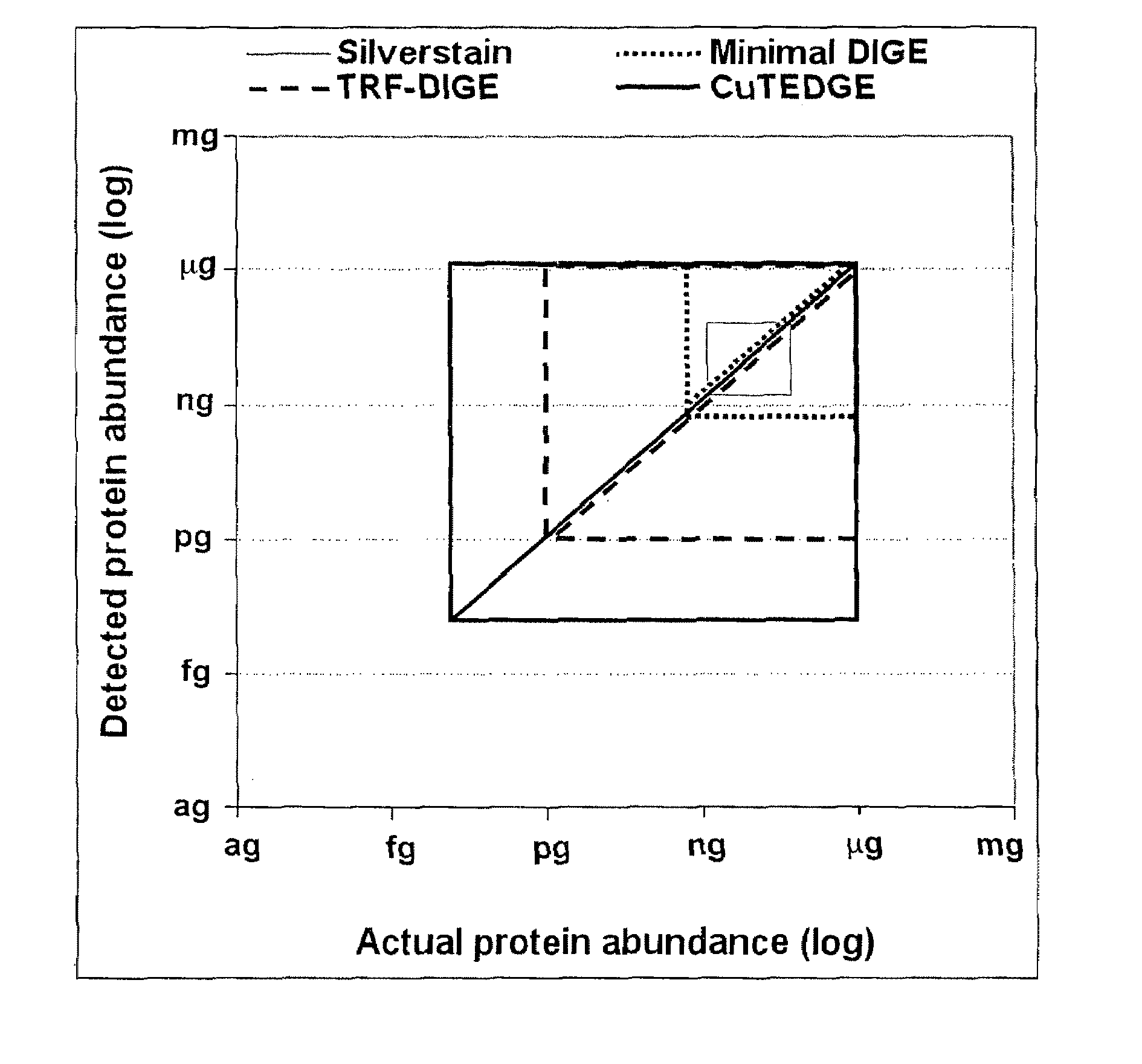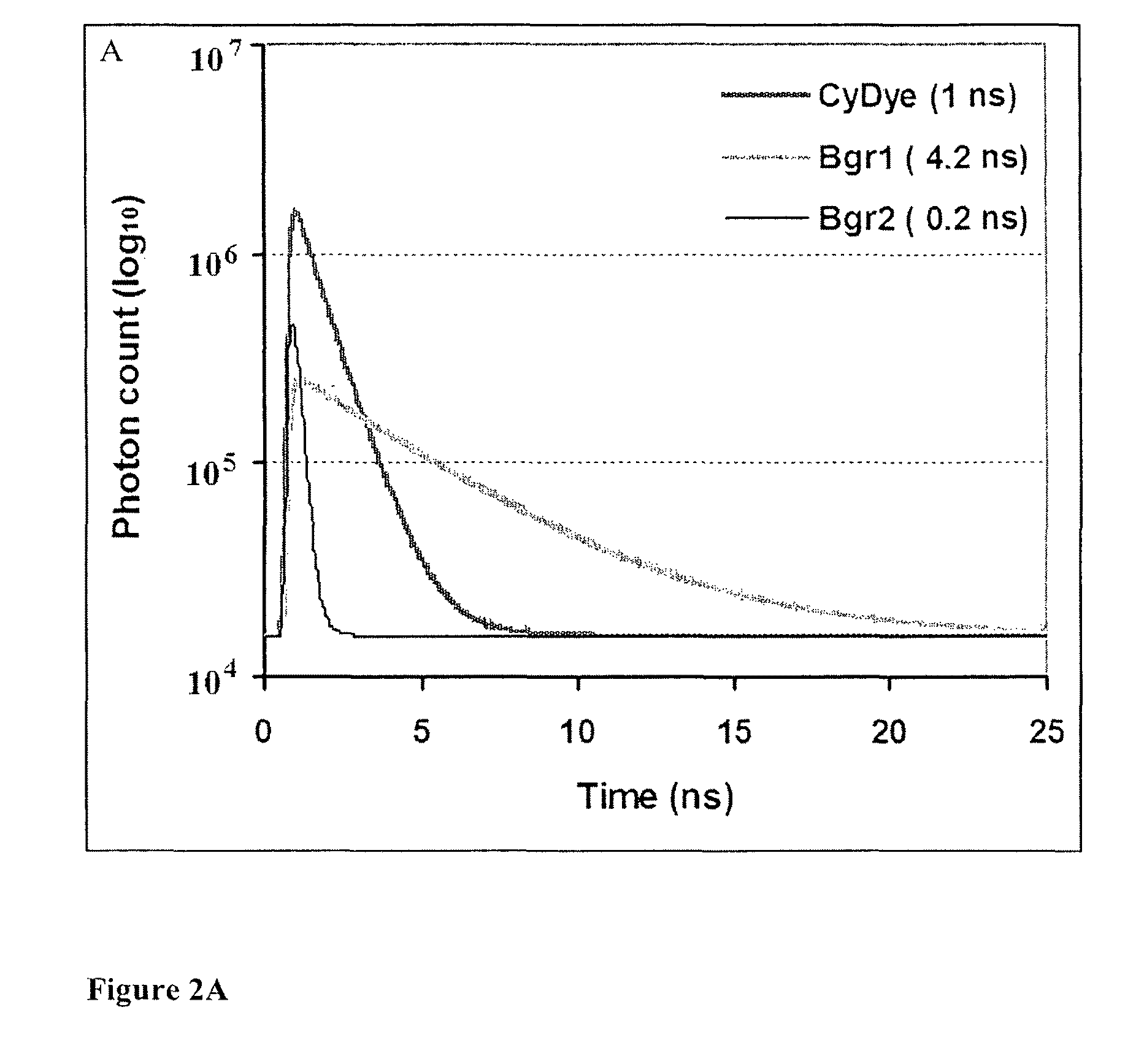Cumulative time-resolved emission two-dimensional gel electrophoresis
a two-dimensional gel and emission technology, applied in the field of cumulative time-resolved emission two-dimensional gel electrophoresis, can solve the problem of compromising the sensitivity of detection in the cutedgeTM application, and achieve the effect of optimal flexibility
- Summary
- Abstract
- Description
- Claims
- Application Information
AI Technical Summary
Benefits of technology
Problems solved by technology
Method used
Image
Examples
example 1
[0057]In this example, proteins are first isolated from rat airway through lysis-lavage (14), an isolation method that instantly solubilizes the airway epithelial proteome in a 2-DGE-compatible urea-based lysis buffer (7M urea, 2M thiourea, 4% w / v CHAPS, 0.5% Triton-X 100, 2% v / v protease inhibitor cocktail). The protein concentration of the samples is determined using the method of Bradford, and separated using 2-DGE. An aliquot of 400 μg protein / sample is diluted to 350 μl with lysis buffer, and IPG buffer for the appropriate pH range is added to a final concentration of 1% v / v. The protein samples are loaded onto the IPG strip (GE Healthcare) through rehydration at room temperature overnight, and isoelectric focusing (IEF) is performed using a Multiphor II Electrophoresis unit and an EPS 3501 XL power supply at 20° C. with the following gradient protocol: 0-50V, 1 min.; 50V, 1 hr; 50-1000V, 3 hr; 1000-3500V, 3 hr; 3500V, 19 hr (total 74.9 kVh). Following IEF, the strips are incub...
example 2
[0062]Macrophages isolated by bronchoalveolar lavage from smoking and never-smoking human subjects are solubilised using 2-DGE lysis buffer (see Example 1). An internal standard is created through pooling of equal amounts of protein from all the subjects included in the study, and labelled with NHS ester-conjugated Cy2 (minimal DIGE reagent) according to the manufacturer's recommendations (GE Healthcare, Uppsala, Sweden). The protein samples from smoker and never-smoker subjects are randomized into two groups, which are labeled with Cy3 and Cy5 minimal DIGE reagents respectively. The Cy2 labeled internal standard is co-separated with one Cy3 and one Cy5 labeled sample on a 2-DGE gel according to the protocol described in Example 1. The three different protein labels are visualized in an automated sequence of three different scanning protocols using a combination of spectral and time-resolved fluorescence as follows:
[0063]A) The Cy2 fluorochrome (internal standard) is excited through...
example 3
[0067]As an additional step to the protocol described in Example 2, SYPRO™ Ruby staining is performed to facilitate quantification of the total protein content in the DIGE gel. In existing technology, it is not possible to utilize the DIGE and SYPRO™ Ruby fluorochromes in the same 2-DGE gels due to spectral overlap, particularly in terms of the emission curves of SYPRO™ Ruby, Cy3 and Cy5. The embodiments of this invention utilize the temporal dimension to facilitate merging of these to standard protocols (as exemplified in FIG. 3). Following completion of the procedures outlined in Example 2, post-staining with SYPRO™ Ruby staining to quantify total protein content is performed according to steps B and C outlined in Example 1.
PUM
| Property | Measurement | Unit |
|---|---|---|
| fluorescent lifetimes | aaaaa | aaaaa |
| fluorescent lifetimes | aaaaa | aaaaa |
| depth | aaaaa | aaaaa |
Abstract
Description
Claims
Application Information
 Login to View More
Login to View More - R&D
- Intellectual Property
- Life Sciences
- Materials
- Tech Scout
- Unparalleled Data Quality
- Higher Quality Content
- 60% Fewer Hallucinations
Browse by: Latest US Patents, China's latest patents, Technical Efficacy Thesaurus, Application Domain, Technology Topic, Popular Technical Reports.
© 2025 PatSnap. All rights reserved.Legal|Privacy policy|Modern Slavery Act Transparency Statement|Sitemap|About US| Contact US: help@patsnap.com



